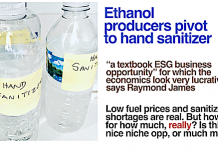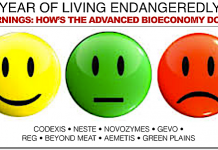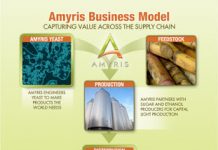Jim Lane
 Portrait of a breakout: Amyris (AMRS), Cosan (CZZ) JV Novii launches “next generation of revolutionary oils” touting “unmatched value” and “unbeatable economics”
Portrait of a breakout: Amyris (AMRS), Cosan (CZZ) JV Novii launches “next generation of revolutionary oils” touting “unmatched value” and “unbeatable economics”
In California, Novvi unveiled two new 100 percent renewable base oil products, a 100 percent renewable polyalphaolefin (PAO) Group IV and a 100 percent renewable version of its NovaSpec Group III+ base oil. Both will be manufactured at the company’s production facility in Houston.
Base oils are blended with additives to make the engine oils and lubricants sold on the market today.
So, here’s the technical scoop. Novvi’s 100 percent renewable PAO is a clean, direct replacement for conventional Group IV PAO base oils derived from petroleum and natural gas. Novvi notes that it is “the first company to commercialize high-performance PAO oil from renewable materials,” and said that its streamlined supply chain drastically “reduces capex costs considered standard in the industry by bypassing upstream processing steps required by petroleum PAO.”
The global polyalphaolefin market
Try saying that three times real fast. Polly Alfa Hola Fin, Polly Alfa…oh, never mind.
What you need to know, in general, is that it is one of those “small-volume, high-margin” markets that equity analysts point to approvingly when they give kudos to advanced biotech companies for finding a breakout early product. The iPhone comes later, first comes the Apple I.
Specifically, according to Transparency Market Research, Group IV & V Lubricants (PAO, PAG and Esters) Market – Global Industry Analysis, Size, Share, Trends and Forecast, 2012 – 2018,” the Group IV & V lubricants demand was 624.6 kilo tons in 2011 and is expected to reach 752.9 kilo tons in 2018, growing at a CAGR of 2.76% from 2013 to 2018. TMR notes that “Group IV & V lubricants have been growing at a faster pace than mineral-based lubricants as they are more fuel efficient and can be used in extreme operating conditions. In addition, there has been positive regulatory support for the development of Group IV & V lubricants from various agencies.”

The leap from 50% to 100% blends
There were three main drivers,” Novvi CEO Jeff Brown told The Digest. “First, there was pull from customers who want to be as green as possible, and don’t want to be 50 percent, they want to be 100%. That was a big part of it.
“Also, there are a lot of customers are blending to a renewable content spec. For example, once you get to 25 percent, you can have a Biopreferred label, and customers want to hit that point efficiently, so they prefer to blend on their own. That way, they have the freedom to hit their targets, and for some it is 50, 70 or 80. So, this gives them blend flexibility, especially considering that a finished product can be made of a blend of several base oils.
“The last piece is great for industry, and that is creating value in the renewable content. There is value in green, and if it more valuable to be at 100% than 50% because of some of the factors we’ve discussed, well, that’s something we should create a structure around.
Market share driver or price premium?
We asked whether the value in green was in driving market share or whether there were price advantages.
“We see both, it depends on the product. If there is a high renewable requirement or a tight clean spec, then there can be a price premium.”

Who’s the customer?
We asked Brown if the demand for Novvi oils was primarily being driven by customer-facing partners in the lubricants business or primarily with blenders and formulators of ingredients.
“We work with customer-facing strategic partners in both, the base oil business and the finished lubricant side.”
What about the business model – is Novvi manufacturing or is licensing in the offing? “We’re doing the manufacturing now but we have a variety of partnership structures with customers, and we will scale production through strategic industry partnerships.”
Will we see expansion of that manufacturing capacity, given the new launches? “Yes,” Brown said, “we have expansion plans on the manufacturing side. First though, we want to move through the product launch period. But we continue to see the market build, and we are seeing the product work, and product adoption.

Policy supports
In the rush to support the creation of renewable fuels, sometimes the afore-mentioned “small-volume, high-margin” products get overlooked as targets for policy supports especially critical for young industries starting with smaller production scales. What’s on the “policy shopping list” for Novvi, if anything, we asked Jeff Brown.
“Novvi is not built to rely on policy support; we can compete on price. But with that said a lot of things can help. To give an example, one of the single biggest factors is a country’s fuel economy standard. The higher those are, the higher performing lubricants are required, so we are an enabler for OEMs and large global players. Beyond that, an eco-label spec and laws on toxicity are helpful.
Policies that sound minor can be huge game-changers. For instance, there’s the new Vessel General Permit guidelines – the VGP.
[Readers, please note: The EPA oversees the Vessel General Permit, and new regulations issued in December 2013 affected all commercial vessels longer than 79 feet in length. The EPA advises: The 2013 vessel general permit requires the use of an environmentally acceptable lubricant for all oil to sea interfaces for vessels unless technically infeasible. The intent of this new requirement is to reduce the environmental impact of lubricant discharges on the aquatic ecosystem by increasing the use of environmentally acceptable lubricants for vessels operating in waters of the United States…Use of environmentally acceptable lubricants results in discharges that biodegrade more quickly and are less toxic than their traditional mineral oil counterparts. For all applications where lubricants are likely to enter the sea, environmentally acceptable lubricant formulations including using vegetable oils, biodegradable synthetic esters or biodegradable polyalkylene glycols as oil bases instead of mineral oils can offer significantly reduced environmental impacts from those applications.]
The VGP offers a staggering potential in volume, and last week the Obama Administration issued new regulations on clean water and protecting streams. Traditional mineral oils can be detrimental to the water supply, so we are seeing a lot of legislation under consideration, for example in California. “But we’re not waiting for anything,” Brown hastened to add.
Comments from industry observers
“Renewable oils offer customization of specs and performance that differentiate them from conventionally produced oils,” said Pavel Molchanov, senior vice president
and equity research analyst at Raymond James. “A renewable oil that competes on performance and price is well positioned for the multibillion dollar lubricant and base oils market.”
“If a company could make the same quality PAO with a different feedstock, they could dramatically change the market. Customers would run to them,” said Joe Rousmaniere, director of business development at Chemlube International.
The Bottom Line
To relate an anecdote that has absolutely nothing directly to do with Novvi, or lubricants, but illustrates a point, this week some 71 years ago Brig. Gen. Theodore Roosevelt Jr., the senior US commander was traveling with the first wave of soldiers landing at Utah Beach on D-Day. With strong tides and seas that day, Roosevelt’s landing craft arrived a mile away from the carefully-selected objective. Whoops. After surveying the options, Roosevelt coolly announced, “We’ll start the war from right here.”
Which is to say, the advanced bioeconomy revolution was not exactly planned around the battle for global market share in base oils. But it makes a very nice beachhead. Good for Novvi.
Jim Lane is editor and publisher of Biofuels Digest where this article was originally published. Biofuels Digest is the most widely read Biofuels daily read by 14,000+ organizations. Subscribe here.









Nice to see that renewable lubricants are catching on in the states. However, I would not expect any great breakthroughs anytime soon. Most lubricant users are extremely conservative (for machine safety reasons), and lubricant markets are dominated by large oil companies. That isn’t to say that renewables aren’t on the way, but large acceptance requires a lot of approvals from OEMs and end users. A couple European companies that has long been involved in renewable base stocks are AAK and Binol as well as Statoil Lubricants. Unfortunately, in most cases the wins from renewables haven’t panned out due to the cost of lubricant vs. the environmental gains vs. the risk for machine failure.